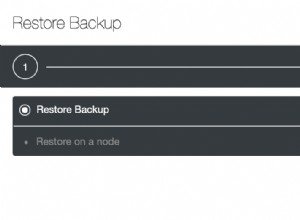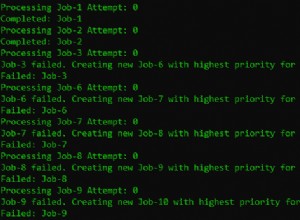In MongoDB, il cursor.sort() il metodo specifica l'ordine in cui la query restituisce i documenti corrispondenti.
Il sort() accetta un documento che specifica il campo da ordinare e l'ordinamento. L'ordinamento può essere 1 per crescente o -1 per la discesa.
Puoi anche specificare { $meta: "textScore" } quando si esegue $text ricerche, per ordinare in base al textScore calcolato metadati in ordine decrescente.
Dati di esempio
Supponiamo di avere una collezione chiamata pets con i seguenti documenti:
{ "_id" : 1, "name" : "Wag", "type" : "Dog", "weight" : 20 }
{ "_id" : 2, "name" : "Bark", "type" : "Dog", "weight" : 10 }
{ "_id" : 3, "name" : "Meow", "type" : "Cat", "weight" : 7 }
{ "_id" : 4, "name" : "Scratch", "type" : "Cat", "weight" : 8 }
{ "_id" : 5, "name" : "Bruce", "type" : "Kangaroo", "weight" : 100 }
{ "_id" : 6, "name" : "Hop", "type" : "Kangaroo", "weight" : 130 }
{ "_id" : 7, "name" : "Punch", "type" : "Kangaroo", "weight" : 200 }
{ "_id" : 8, "name" : "Snap", "type" : "Cat", "weight" : 12 }
{ "_id" : 9, "name" : "Ruff", "type" : "Dog", "weight" : 30 } Ordina in ordine crescente
Per ordinare in ordine crescente, utilizziamo 1 per l'ordinamento.
Di seguito è riportato un esempio di una query che utilizza $sort operatore per ordinare la raccolta in base al weight campo in ordine crescente.
db.pets.find().sort({ weight: 1 })Risultato:
{ "_id" : 3, "name" : "Meow", "type" : "Cat", "weight" : 7 }
{ "_id" : 4, "name" : "Scratch", "type" : "Cat", "weight" : 8 }
{ "_id" : 2, "name" : "Bark", "type" : "Dog", "weight" : 10 }
{ "_id" : 8, "name" : "Snap", "type" : "Cat", "weight" : 12 }
{ "_id" : 1, "name" : "Wag", "type" : "Dog", "weight" : 20 }
{ "_id" : 9, "name" : "Ruff", "type" : "Dog", "weight" : 30 }
{ "_id" : 5, "name" : "Bruce", "type" : "Kangaroo", "weight" : 100 }
{ "_id" : 6, "name" : "Hop", "type" : "Kangaroo", "weight" : 130 }
{ "_id" : 7, "name" : "Punch", "type" : "Kangaroo", "weight" : 200 } Ordina in ordine decrescente
Per ordinare in ordine decrescente, utilizziamo -1 per l'ordinamento.
db.pets.find().sort({ weight: -1 })Risultato:
{ "_id" : 7, "name" : "Punch", "type" : "Kangaroo", "weight" : 200 }
{ "_id" : 6, "name" : "Hop", "type" : "Kangaroo", "weight" : 130 }
{ "_id" : 5, "name" : "Bruce", "type" : "Kangaroo", "weight" : 100 }
{ "_id" : 9, "name" : "Ruff", "type" : "Dog", "weight" : 30 }
{ "_id" : 1, "name" : "Wag", "type" : "Dog", "weight" : 20 }
{ "_id" : 8, "name" : "Snap", "type" : "Cat", "weight" : 12 }
{ "_id" : 2, "name" : "Bark", "type" : "Dog", "weight" : 10 }
{ "_id" : 4, "name" : "Scratch", "type" : "Cat", "weight" : 8 }
{ "_id" : 3, "name" : "Meow", "type" : "Cat", "weight" : 7 } Ordina per più campi
Per ordinare in base a più campi, separa ogni campo/combinazione di ordinamento con una virgola.
Esempio
db.pets.find().sort({ type: 1, weight: -1, _id: 1 })Risultato:
{ "_id" : 8, "name" : "Snap", "type" : "Cat", "weight" : 12 }
{ "_id" : 4, "name" : "Scratch", "type" : "Cat", "weight" : 8 }
{ "_id" : 3, "name" : "Meow", "type" : "Cat", "weight" : 7 }
{ "_id" : 9, "name" : "Ruff", "type" : "Dog", "weight" : 30 }
{ "_id" : 1, "name" : "Wag", "type" : "Dog", "weight" : 20 }
{ "_id" : 2, "name" : "Bark", "type" : "Dog", "weight" : 10 }
{ "_id" : 7, "name" : "Punch", "type" : "Kangaroo", "weight" : 200 }
{ "_id" : 6, "name" : "Hop", "type" : "Kangaroo", "weight" : 130 }
{ "_id" : 5, "name" : "Bruce", "type" : "Kangaroo", "weight" : 100 }
In questo esempio, abbiamo ordinato per type campo prima in ordine crescente, poi in base al weight campo in ordine decrescente, quindi dal _id campo in ordine crescente.
Ciò significa che, se sono presenti più animali domestici dello stesso tipo, tali animali domestici vengono ordinati in base al loro weight in ordine decrescente. Se ci sono più animali domestici con lo stesso tipo e peso, questi animali vengono ordinati in base al _id campo in ordine crescente. Se non avessimo incluso il _id campo nel processo di smistamento, gli animali domestici dello stesso tipo e peso potrebbero apparire in qualsiasi ordine. Questo è vero ogni volta che eseguiamo la query. Senza avere un campo di ordinamento su un campo univoco (come il _id campo), sarebbe del tutto possibile (anche probabile) che i risultati tornino in un ordine diverso ogni volta che viene eseguita la query.
Ordinamento di tipi diversi
Quando si confrontano valori di diversi tipi BSON, MongoDB utilizza il seguente ordine di confronto, dal più basso al più alto:
- MinKey (tipo interno)
- Nulla
- Numeri (int, long, double, decimali)
- Simbolo, Stringa
- Oggetto
- Matrice
- BinData
- ID oggetto
- Booleano
- Data
- Data e ora
- Espressione regolare
- MaxKey (tipo interno)
Supponiamo di avere una raccolta chiamata post con i seguenti documenti:
{
"_id" : 1,
"title" : "Web",
"body" : "Create a funny website with these three easy steps...",
"date" : "2021-01-01T00:00:00.000Z"
}
{
"_id" : 2,
"title" : "Animals",
"body" : "Animals are funny things...",
"date" : ISODate("2020-01-01T00:00:00Z")
}
{
"_id" : 3,
"title" : "Oceans",
"body" : "Oceans are wide and vast, but definitely not funny...",
"date" : ISODate("2021-01-01T00:00:00Z")
}
Nota che la prima date contiene una stringa di data, mentre gli altri due documenti utilizzano un oggetto Date.
Si noti inoltre che la stringa della data contiene esattamente la stessa data del documento 3 e questa data è successiva alla data nel documento 2.
Ordiniamo per date campi di tali documenti:
db.posts.find().sort({ date: 1 }).pretty()Risultato:
{
"_id" : 1,
"title" : "Web",
"body" : "Create a funny website with these three easy steps...",
"date" : "2021-01-01T00:00:00.000Z"
}
{
"_id" : 2,
"title" : "Animals",
"body" : "Animals are funny things...",
"date" : ISODate("2020-01-01T00:00:00Z")
}
{
"_id" : 3,
"title" : "Oceans",
"body" : "Oceans are wide and vast, but definitely not funny...",
"date" : ISODate("2021-01-01T00:00:00Z")
} In questo caso abbiamo ordinato in ordine crescente, il che significa che le date precedenti dovrebbero venire prima. Tuttavia, il nostro primo documento contiene una stringa di data anziché un oggetto Date, quindi è arrivato per primo, anche se la sua data è successiva alla data nel documento 2.
Eccolo di nuovo, ma in ordine decrescente:
db.posts.find().sort({ date: -1 }).pretty()Risultato:
{
"_id" : 3,
"title" : "Oceans",
"body" : "Oceans are wide and vast, but definitely not funny...",
"date" : ISODate("2021-01-01T00:00:00Z")
}
{
"_id" : 2,
"title" : "Animals",
"body" : "Animals are funny things...",
"date" : ISODate("2020-01-01T00:00:00Z")
}
{
"_id" : 1,
"title" : "Web",
"body" : "Create a funny website with these three easy steps...",
"date" : "2021-01-01T00:00:00.000Z"
} Ancora una volta, i diversi tipi di dati vengono ordinati separatamente al loro interno.
Ordinamento metadati punteggio testo
Puoi usare il { $meta: "textScore" } argomento da ordinare in base al punteggio di pertinenza decrescente quando si utilizza $text ricerche.
Esempio
db.posts.find(
{ $text: { $search: "funny" } },
{ score: { $meta: "textScore" }}
).sort({ score: { $meta: "textScore" } }
).pretty()Risultato:
{
"_id" : 2,
"title" : "Animals",
"body" : "Animals are funny things...",
"date" : ISODate("2020-01-01T00:00:00Z"),
"score" : 0.6666666666666666
}
{
"_id" : 3,
"title" : "Oceans",
"body" : "Oceans are wide and vast, but definitely not funny...",
"date" : ISODate("2021-01-01T00:00:00Z"),
"score" : 0.6
}
{
"_id" : 1,
"title" : "Web",
"body" : "Create a funny website with these three easy steps...",
"date" : "2021-01-01T00:00:00.000Z",
"score" : 0.5833333333333334
}
In questo esempio, abbiamo ordinato per { $meta: "textScore" } .
Da MongoDB 4.4 la riga che va { score: { $meta: "textScore" }} è facoltativo. Omettendo questo ometterai il score campo dai risultati. Pertanto, possiamo fare quanto segue (da MongoDB 4.4):
db.posts.find(
{ $text: { $search: "funny" } }
).sort({ score: { $meta: "textScore" } }
).pretty()Risultato:
{
"_id" : 2,
"title" : "Animals",
"body" : "Animals are funny things...",
"date" : ISODate("2020-01-01T00:00:00Z")
}
{
"_id" : 3,
"title" : "Oceans",
"body" : "Oceans are wide and vast, but definitely not funny...",
"date" : ISODate("2021-01-01T00:00:00Z")
}
{
"_id" : 1,
"title" : "Web",
"body" : "Create a funny website with these three easy steps...",
"date" : "2021-01-01T00:00:00.000Z"
}
Fare $text ricerche come questa richiedono la creazione di un indice di testo. In caso contrario, un IndexNotFound verrà restituito l'errore.
Maggiori informazioni
Consulta la documentazione di MongoDB per ulteriori informazioni.




